
- Homepage
- Brand
- Artoria (30)
- Artoria Limoges (13)
- Atelier (7)
- Chamart (26)
- Elda Creations (7)
- La Reine (11)
- Lagloriette (9)
- Le Tallec (23)
- Limoges (2497)
- Limoges - Artoria (7)
- Limoges - Chamart (11)
- Limoges - Rochard (18)
- Limoges France (26)
- Limoges Peint Main (7)
- Parry Vieille (8)
- Peint Main (14)
- Rochard (109)
- Rochard Limoges (53)
- Tiffany & Co (17)
- Tiffany & Co. (25)
- ... (2975)
- Collection
- Animals (41)
- Cats (5)
- Chamart (4)
- Christmas (12)
- Disney (4)
- Frogs (3)
- Halloween (5)
- Holiday (4)
- Keepsake Boxes (98)
- Limited Editions (78)
- Limoges (58)
- Limoges Box (18)
- Love (14)
- Love, Romance (6)
- Nativity (5)
- Peint Main (8)
- Rochard (7)
- See Item Description (4)
- Trinket Box (14)
- Unknown (7)
- ... (5498)
- Finish
- Material
- Bone China (7)
- Brass (10)
- Brass, Porcelain (44)
- Ceramic (9)
- Ceramic & Porcelain (32)
- China / Porcelain (3)
- Enamel (5)
- Glass (7)
- Limoges Porcelain (2)
- Metal (12)
- Metal, Porcelain (3)
- Porcealin (2)
- Porcelain (1678)
- Porcelain & Metal (6)
- Porcelain / China (20)
- Porcelain And Metal (5)
- Pottery (3)
- ... (4045)
- Occasion
- Type
- Bottles (3)
- Box (46)
- Boxes (15)
- Boxes / / Trinkets (2)
- Boxes / Trinkets (3)
- Dresser Box (3)
- Hinged Box (2)
- Hinged Trinket Box (195)
- Jewelry Box (4)
- Keepsake Trinket Box (2)
- Limoges Box (5)
- Limoges Trinket Box (4)
- Miniature (3)
- Porcelin (2)
- Tray (2)
- Trinket (3)
- Trinket / Pill Box (2)
- Trinket Box (1730)
- Trinket Boxes (2)
- Trinket Pill Box (2)
- ... (3863)
LACQUER Box Russian EASTER 1936 Blond man GAY INTEREST J. C. Leyendecker signed
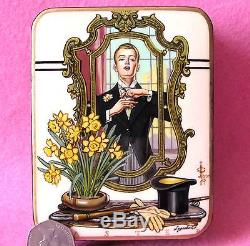
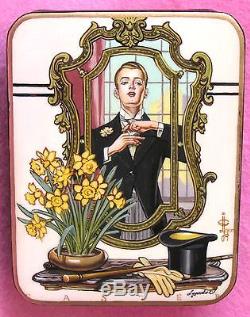
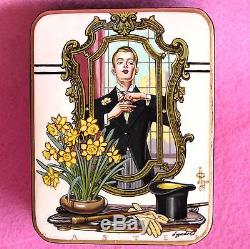
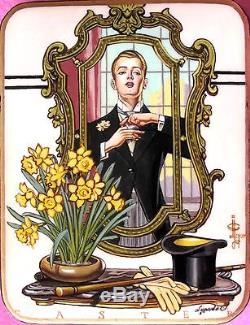
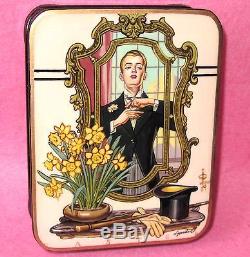
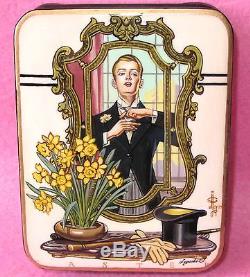
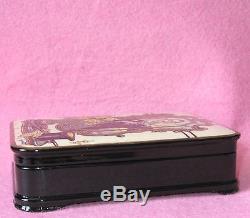
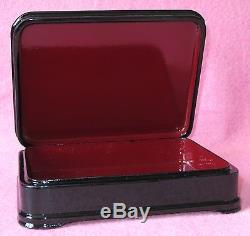


This is a beautiful and unique Russian FEDOSKINO papie mache trinket/jewellery Box depicting handsome young man getting ready to go out "EASTER" 1936 by J. Leyendecker , hand painted and signed by the Russian Artist.
The box measures 13.1 cm (5 3/16 inches). 10.2 cm (4 inches) wide, 1.8 cm deep. Before Rockwell, a Gay Artist Defined the Perfect American Male. Body had to tell J. Before the conservative backlash of the mid-20th century, the American public celebrated his images of sleek muscle-men, whose glistening homo-eroticism adorned endless magazine covers. Yet Leyendeckers name is almost forgotten, whitewashed over by Norman Rockwells legacy of tame, small-town Americana. Rockwell was just an 11-year old kid when Leyendecker created the legendary Arrow Collar Man in 1905, used to advertise the clothing companys miraculous detachable collars. One of Americas first recognizable sex symbols, this icon of masculinity was defined by his poise and perfection, whether on the sports field or at the dinner table. Like the Gibson Girl, the Arrow Collar Man developed a singular identity, equal parts jock and dandy, who supposedly received more fan letters than silent film heartthrob Rudolph Valentino.To top things off, Leyendeckers men were often modeled after his lover and lifetime companion, Charles Beach, making their secret romance a front-page feature across the U. Born in 1874, Joseph Christian Leyendecker emigrated with his family from Germany to Chicago in 1882 and soon began apprenticing with illustrators. To view more Leyendecker images, see our slideshow. While Leyendecker was also known for his depictions of apple-cheeked children and elegant women, it was his stern, brooding men who created the greatest impact.
Leyendeckers fictional world of affluence and beauty influenced other pop-culture touchstones, like the fantastic setting of F. Scott Fitzgeralds The Great Gatsby. As fashions changed and the U. Entered World War II, Leyendeckers career slumped, curbing his extravagant lifestyle.Alfredo Villanueva-Collado, a former literature professor at the City University of New York and established collector of Bohemian art glass, filled us in on his J. Leyendecker collection and the fascinating story behind this oft-neglected male image maker.
This is a lovely painted picture and the photo doesn't do it justice!!! The box is signed on the back with Artists signature. The term lacquer is applied not only to the special coating liquids but also to the articles so treated, whether they are made of wood, metal or paper mashe. The technique originated in Japan, China and Persia and oriental lacquer work first became known in Europe in the 16th century. By the 18th century lacquer snuffboxes decorated with miniatures and made in England, France and Germany had become fashionable. One of the greatest European centers for such items was Johann Stobwasser's manufactory in Braunschweig. In 1795 the Russian merchant Pyotr Korobov visited the Braunschweig works and his enterprising mind quickly grasped that cheap and simple articles could be mass-produced using this very durable combination of materials. Within a year he had opened his own factory on the outskirts of Fedoskino. At first it employed just over twenty people.However, the factory also became famous for its simple, most often round, snuffboxes. The "golden age" of the Russian lacquers would begin after 1819 when the factory passed into other hands: his son-inlaw Pyotr Lukutin and the latter succeeded Korobov by his own son Alexander.
The originality of the scenes depicted and the high quality of these articles made the Fedoskino masters so famous that in 1828 Lukutin was given the right to insert the Russian coat of arms and his own surname on the boxes. The most important article of production remained the snuffbox.
But now it was made in a variety of shapes, symmetrical oval, and rectangular and more complex forms. The box fitted snugly in the hand and its edges were smoothly rounded. All the minor details such as the rim of the lid and the delicate frame around the miniature were finely delineated. Each of these centers follows one of the two varieties of lacquer painting, using oils or tempera.The FEDOSKINO tradition derives from Russian classical painting and miniatures of the 18th and early 19th centuries and the Russian folk arts. There three to four layers of oil paint are applied, each being dried and coated with a transparent lacquer, before the entire completed work is polished.
The several layers of painting result in a tonal richness and glowing of the colors. The paints are applied in thick opaque layers and in "through-painting" with translucent paints over an under-layer of gold leaf or mother of pearl which makes the colors seem to sparkle from within.Gold, silver and bronze powders were often employed instead of gold leaf. Such multiple layers of painting are one of the striking features of the Fedoskino miniature. Please leave feedback once you have recived the item so that i know it has arrived safely. I will leave feedback in return. We speak French , English , German and Russian.
Smoke & Pet Free Item. The item "LACQUER Box Russian EASTER 1936 Blond man GAY INTEREST J. Leyendecker signed" is in sale since Tuesday, December 12, 2017. This item is in the category "Collectibles\Decorative Collectibles\Decorative Collectible Brands\Limoges\Trinket Boxes". The seller is "tom3burma" and is located in Norwich. This item can be shipped worldwide.- Subtype: Lacquer Box
- Type: Boxes// Trinkets
- Country/Region of Manufacture: Russian Federation

